- World War II and the V-M 400
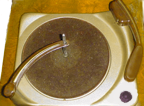
V-M 400
The V-M 400 is probably the most misportrayed machine.
First made in 1947, it was used in many prewar and World War II movie and TV settings.
It was the first record changer ever made with a record-balancing overarm such as the one shown.
This record changer was first made two years after the end of the war these movies containing it portray.- In ????? (????)*, this record changer was on the table at the soldiers'
meeting for the upcoming D-Day.
− Records were being played on it for the soldiers before the meeting.
− This is the movie with the lines:
"You captured six German soldiers with your what?"
"With my mine detector".
* I know I have a DVD of this, but I can't find which one.
- In The Enemy Below (1957), a German U-boat was shown with this American
record changer as the ship's turntable (huh?).
− The German captain orders a record to be played for crew morale in a dying submarine.
− We see a crewman in silhouette put the record on the ledge of a tall spindle and lower the overarm onto it.
− The crewman starts the changer, it drops the record, and the record plays.
− The American SONAR operator reports "Screwy noises from the hydrophone".
- In an episode of the TV series Baa-Baa Black Sheep, this was the turntable for
the camp PA.
− A Japanese soldier trying to stop it from playing Reveille kept hitting the wood table it was on with his rifle.
− Because this changer has eccentric trip, each time he hit the table, it started a change cycle.
− Because the overarm was up to the side, each change cycle started the record to play again from the beginning.
− To stop it, the soldier shot it with his machine gun.
The control knob has three positions: OFF, ON, and REJ. REJ is a momentary position that starts a change cycle.
This was the first record changer ever made that was very easy to use.
Load it, put the overarm on the records, and start it. It shuts off after the last record.
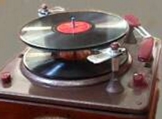
V-M 200

Webster 70
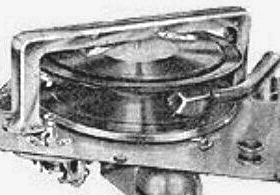
Collaro RC1
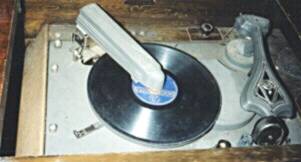
RCA Duo
No overarm-type changers of this kind were made before the end of World War II.
They were ubiquitous after 1947, with V-M, Collaro, and Philips making overarm changers.
All prewar changers with long spindles had knife shelves, (upper left),
a tilted stack (upper right), or a thick long crossbar (lower left).
All other prewar record changers did not have long spindles (lower right).No record changers were made during the war. Manufacture of such products was forbidden by law.
The V-M changers were used in movies and TV because these props were closest in age to prewar changers.
Most prewar record changers went to scrap drives after they broke the new substandard war-rationed records.
They didn't want changers that broke records used in movie takes. A broken record is a ruined take.
Most directors didn't know one record changer from another. They just asked props for a period record changer.
Props men figured that most of the audience would not know what year that record changer was first made.
- In ????? (????)*, this record changer was on the table at the soldiers'
meeting for the upcoming D-Day.
- Korean War - Changers from the late 1950s and early 1960s:
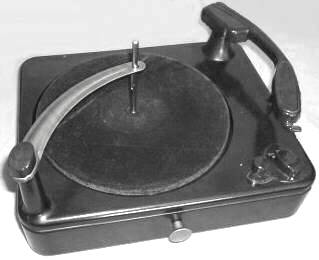
V-M 405

Admiral RC800

VM 1229
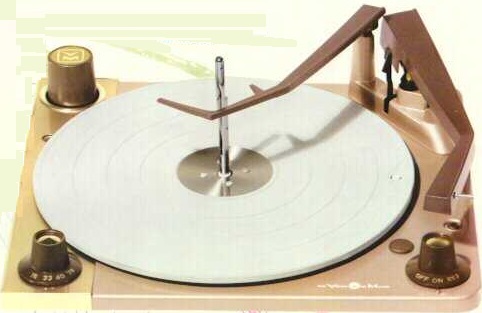
VM-1571
They used record changers from the late 1950s and early 1960s in Korean War (1950-1953) movie and TV settings.
- In an episode of the TV show M*A*S*H, this record changer was
in Major Charles Emerson Winchester III's portable record player.
− Colonel Potter commandeered the player to put music on the PA for camp morale.
− The pickup arm and overarm design places this changer as being made after 1955.
− The top two changer images show arm and overarm designs from the early 1950s.
− Note the rounded arm and overarm edges typical of this period.
− Note also the overarm is close to the spindle (or the 45 spindle).− The bottom two changer images show later arm and overarm designs.
− Note the arm and overarm edges are squared off.
− Note also the overarm is angular and farther from the spindle.
− This is closer to the changer seen in the episode.Not enough of the changer is ever shown to identify it conclusively,
Another episode definitely shows the overarm that is on the VM-1571.
- In an episode of the TV show M*A*S*H, this record changer was
in Major Charles Emerson Winchester III's portable record player.

Garrard RC-100
This was to be the top of the line Garrard record changer in 1939.
It could play one or both sides of 78 or 33 rpm records and had a recording attachment.
In the film, the instruction book kept repeating the line, "It's so simple, it operates itself."
When the main character in the film tries to record on a blank record, it did everything but record.
It kept starting change cycles and either turned the recording blank over or dropped it on the floor.
This photo shows a table and a drawer records drop into. The portable in the film didn't have these.
The resulting record (in the story) was recorded at the wrong speed.
The sad sequel: Very few RC-100s exist. Most were on a US-bound ship sunk by a German U-boat.
War factory takeovers meant no more were ever made. This is the rarest record changer known.
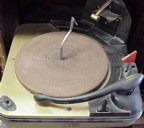
Zenith Cobra-Matic
In the story, Carter was trapped somewhere outside of the camp.
To hide his absence, they said he had a high fever and was confined to Hogan's quarters.
A dummy was in the bed.
This record changer (probably a postwar model) repeated a record with snoring on it.
A piece of cardboard on the push post and another record on top made the record repeat.
While Schultz was inspecting the main room, the cardboard fell out.
The other record dropped and started playing a Tommy Dorsey song.
Schultz said, "What's that?"
Hogan said "Glenn Miller."
Then he yelled out the door "Turn that down! We got a sick man in here!"
After Schultz left, Hogan set up the changer to repeat the snoring record again.
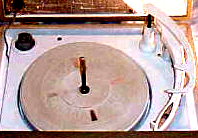
Collaro Conquest
In many cases, a Magnavox Micromatic changer (right, a form of the Collaro Conquest) was used to play the record.
When Briggs or Phelps started the record playing, we saw the arm-scan measure and play the record normally.
At the end of each recording, the voice said, "This recording will self-destruct in 10 seconds."
Those who know a Collaro Conquest know that 10 seconds later, the arm scans for more records.
That would interfere with the recurring plot device "will self-destruct in 10 seconds".
They edited the arm-scan out of the change cycle footage so the record could self-destruct on time.
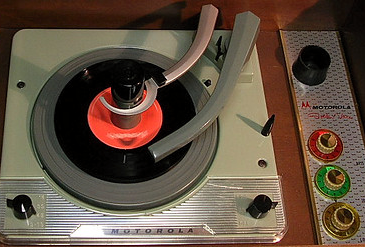
VM changer

Garrard RC-210


1 inset 2
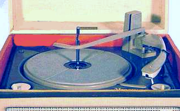
BSR UA-15
- In one episode, a record changer was touted by a salesman as "featherlight
automatic changer, and of course, discomatic".
− Discomatic? What's that?
− It was the brand name of a portable jukebox first sold in the UK several years after the episode was made.
− It was also a European floor cleaning machine.
- Another episode shows a Garrard RC-210 (middle right) in a console playing a 45 rpm
record.
− The testimony said the record was playing loud, over and over, in the murder room. So people called the police.
− There is no way a Garrard RC-210 can repeat a record over and over.
- A record player said to be one for a hi-fi enthusiast was really a cheap portable.
- A BSR UA-15 (bottom right) with a 45 spindle and the overarm up is repeating a record in the murder room. It behaves as it should.
- A VM changer in a console (similar to upper right) plays a 12-inch 33 rpm
record at a party. The overarm is up over the rest post.
− This changer set like this would repeat this record over and over as a 10-inch record.
− But a witness said the loud music stopped when the record ended.
- In another episode Paul Drake's Dilemma, there were several items and errors:
− The record involved was a demo of one song cut late that day to replace one with a bad note.
− It takes time to put lead-in and finishing grooves on a cutting, so it would not have them if recorded that day.
− Perry Mason made the point of asking how the fixed record got to the murder room.
− Since it was a 12-inch 33 rpm record of one song, its maximum playing time would be near 3.5 minutes.
Note that 3.5 minutes was the longest allowed by most radio stations for airplqay.− Sometimes we see this record turning at 78 rpm and sometimes at 33 rpm.
− It was found playing in the murder room on a record changer (another Garrard RC-210 - middle right).
− The overarm is down by the spindle, meaning it would shut off after the record ends with almost any record changer.
− There is no way a stock Garrard RC-210 can repeat a record over and over.
− We actually see this changer trip and start the record over in the show!
The index semaphore (inset 1) is the short arm with the curved end above the pickup arm. It feels the size of the next record.
Normally the index semaphore moves forward toward the spindle. When it finds no record (inset 2), the changer shuts off.
The index semaphore did not come forward in the show, so the changer repeated a 12-inch record.
The production studio for the show somehow rigged the changer to repeat.− A 33 with no lead-in or finishing groove could not trip the change cycle, so it can't repeat even if the changer can repeat.
They must have faked repeating the record using a normal pressed LP with lead-in and finishing grooves.− Thus, the murder had to be discovered and police arrive within 3.5 minutes of when the record started...
Except that we see the changer repeat it. This scenario is improbable without studio trickery.− Perry Mason puts this record up on the spindle of a BSR UA-15 (bottom right) record changer in a portable player in court.
The record drops and it plays normally (it shouldn't).The directors and screenplay writers obviously didn't know how long it takes to make a standard pressing that a record changer can play automatically.
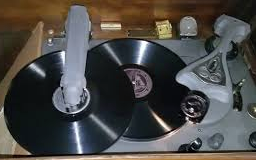
RCA Duo
The setting is in prewar New York City
They are being played on a prewar slide-type (throwoff) record changer (probably RCA).
Movie goers actually get to see the change cycle (right).
The stack is loaded on the turntable. The top record is played first.
The changer arm slides the top record off the turntable and shoves it to the left.
It is amazing that they had it, because most of these were recycled to scrap drives.
These changers broke the substandard records made under war rationing rules.
No slide-type record changers were made after the war because they break wartime records.
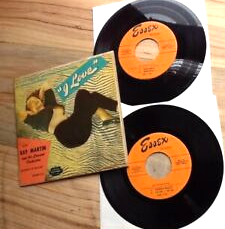
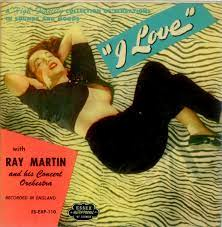
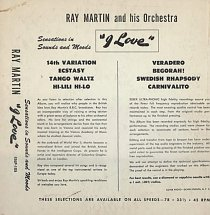
Essex Records 45, 33, 33
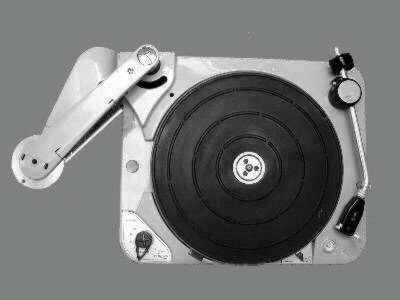

Thorens TD-224

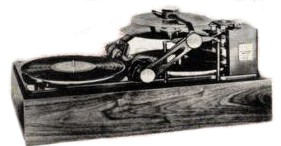
Fisher Lincoln
In the 1930s, record companies were making records in three different sequences:
- Manual sequence - for manual turntables and two-side record changers
- Drop sequence - for changers with long spindles that drop records one by one
- Slide sequence - for changers that slide records off the stack (reverses the stack - see item above)
After Slide changers broke substandard wartime records, they stopped making Slide changers and records.
I have the same Ray Martin album as two 7-inch 45s and as one 10-inch 33 (upper row) on
Essex records.
− But the 45s must play in Slide order to hear the song order
on the 33. Why?
− No Slide changers that play 45s existed while this
album was sold (1950s).
− Some jukeboxes play 45 albums in Slide sequence.
Two record changers were made later (1960s) that change records in the Slide sequence.
− Thorens TD-224 (middle row) - an assembly line changer.
− Fisher Lincoln 70 (lower row) - a one-side (slide) or two-side
(manual) changer.
− Both changers reverse the stack order as they play the stack.
− Neither changer plays Drop albums in correct order without restacking after
the first sides.
No Slide-sequence albums were made since 1942 (excepting those Essex 45 albums).
So why were these changers made to change in Slide order?
Because they handled records gently?
Or maybe the engineers didn't notice the changer reversed the
stack until it was too late.
Both of these changers put only one record on the turntable at a time.
Both of these changers could play odd record sizes and could take intermixed sizes in a stack.
Earlier versions of the Lincoln played records in Drop order. Why did they change it?
Note: Any album sequence can be played in correct order on any changer with two copies of the album.
Note: I have one album with side numbers on the records as Slide, but actually plays Drop sequence.
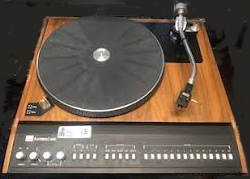
ADC Accutrac 4000
The turntable was an ADC Accutrac 4000.
This turntable can be programmed to play individual tracks or sequences of tracks on records.
The victim was blackmailing the murderer, so he shot the victim with a gun with a silencer.
He then staged fake sounds of a murder to give himself an alibi:
- He balanced an unabridged dictionary on a shelf so it would fall if something fell on it.
- He put two blasting caps in the fireplace chimney.
- He wired the blasting caps to a battery and to the tonearm and two stops on the record player with alligator clips.
- He put a 5 track record on and programmed the player to play tracks 3 and 15.
- He stood a felt-tip marker by the rest post on the player. Then he went downstairs to where others in the house were.
- When track 3 of the record finished playing, the arm raised and tried to play track 15.
- Because no track 15 existed, the arm struck a stop and set off a blasting cap.
- The arm then returned to rest, setting off another blasting cap and knocking off the marker.
- The marker fell on the dictionary, making it fall off the shelf.
- People downstairs heard what sounded like two shots, followed by a body falling.
- Before the police got there, the murderer slipped the wiring into his umbrella while "examining the scene".
- Lt. Columbo was trying to figure out why the pickup arm did what it was doing when the start button was pressed.
- Columbo was able to figure out how the murder really happened from clues he found and what witnesses said.
I have repaired ADC Accutrac 4000 players. All of the parts the wires were connected to are grounded.
Thus, one part touching another could not set off a blasting cap because they are always connected together.
The caps would have gone off as soon as the murderer connected them.
That clip on the tonearm could have caused the stylus to jump out of the groove, making the record stick in one place.
The arm is grounded because, if it weren't, static electricity from the record could affect it, often lifting it off the record.
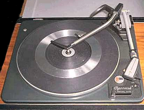
Garrard AT-6
He told Norman and Leon that the record would play over and over.
But he used a Garrard AT-6 and he put the record up on the spindle and put the overarm on the record.
A timer turned on the changer after Norman and Leon had time to go to sleep. The record dropped and it played.
The overarm being on the record causes the changer to shut off after it plays the record once.
The record could not have played over and over as Merlin had said.
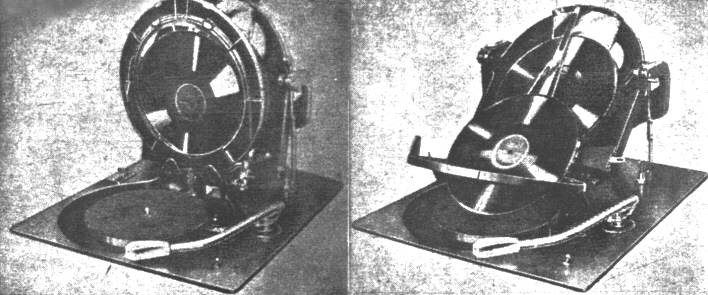
Capehart Turnover
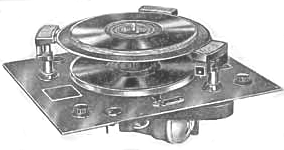
Garrard RC-1

Collaro RC-1
The article was about the Capehart turnover changer (upper image). It turns records over.
It also told how record companies made different sequences (see above) for record changer use.
The Capehart can play the Manual sequence and the Slide sequence.
The author said that the first drop changer was the Garrard RC-1, made in 1930.
They said that the Garrard RC-1 used the Drop sequence.
The Capehart could not play the Drop sequence correctly.
The article included photos of the various changers that used various changer sequences.
One of the photos was captioned as being the Garrard RC-1 (lower left).
The problem is that this photo in the article was actually of a Collaro RC-1 (lower right).
Both are drop changers and use the Drop sequence. But the Collaro appeared several years later.
Note: The author of this web page has the article, but can't find the magazine in his large collection.
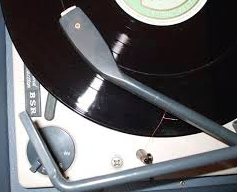
BSR UA-25
A BSR UA-25 changer like this one was shown playing a single 12-inch LP while the actors talked.
The overarm was up and to the side while the record was playing.
When the overarm is up, this changer repeats the last record as a 7-inch record.
In the show the music stopped playing when the song was over. The changer was not on the screen then.
The changer as shown on the TV (and here) would have repeated part of the record at the 7-inch position.
I don't know which TV show this was. It was on in a doctor's waiting room and I was called in before I could find out.

Record on stick

Thunderdome turntable
A group of orphaned kids have a phonograph record on a stick.
There is a string through the center hole of the record tied to branches of the forked stick
As they travel on foot, they hold the record up on the stick like a flag.
They know that spinning the record is important. They say "sonic" when they spin it.
When they meet up with Max, they find an old transport truck with a wind-up turntable. The tonearm is on the left side.
One of the kids winds up the turntable crank and the turntable starts spinning. But it spins counterclockwise.
One of the kids says "Sonic?" Another one says "It must be!"
They take the record off the stick and put it on the turntable. The warps it had while on the stick magically disappear.
The kids wait, but no sound comes out of the record.
Max then picks up the tonearm and places the needle on the record. It plays a French lesson.
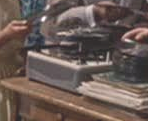
Dance changer

V-M Changer
In the left photo, the changer is loaded with large records.
Some of the kids were looking at 7-inch and 12-inch records. The stack seems to be 10-inch records.
At most dances, they would play only one record at a time so the next song can be on a different record.
When the phonograph table is knocked over, no shattered record pieces appear. They weren't shellac 78s.
LPs are not normally played, let alone stacked, at dances.
The front of the V-M base (right) is identical to the base of the changer in the movie (left).
This was staged for the movie. It would never happen at a real dance.
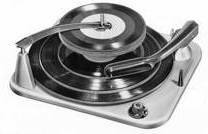
V-M 950 Ad
This V-M 950 changer cannot take 7-inch records in the same stack with larger records.
These changers have a feeler next to (or in) the turntable to tell if 7-inch records or larger records are being played.
(The feeler is visible in the photo next below. It is the black rubber button between the turntable and the arm.)
An advertising "expert" put this photo in magazine ads to show that all three sizes play automatically on it.
If anyone actually tried to play this stack, the arm would set down at the 10-inch position whenever a 7-inch record dropped.
The spiders in the 7-inch records show that they are 45 rpm.
V-M never made a changer that could take mixed speeds.

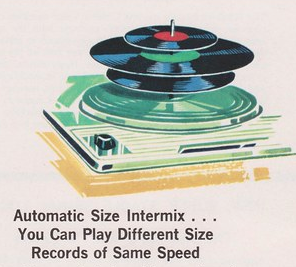
Motorola with V-M 1200
This ad was for a changer in a Motorola console in the early 1960s.
I (page author) saw this ad in a Sears store and pointed out the error then.
This V-M 1200 changer cannot take 7-inch records in the same stack with larger records.
These changers are essentially the same as the V-M 950 above.
(The changer has the same mechanism and the same limitations.)
They put this diagram in magazine ads and brochures to show that all three sizes play automatically on it.
It says "Automatic Size Intermix... You Can Play Different Size Records of Same Speed"
In the shown stack, the arm would set down at the 10-inch position when the 7-inch record drops.
This diagram shows a turntable bigger than a 12-inch record. The real turntable is 9.5 inches across.
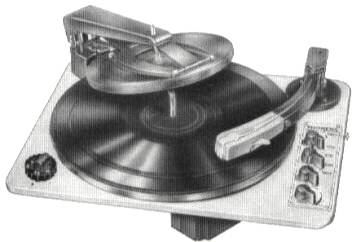
New Thorens CD-43
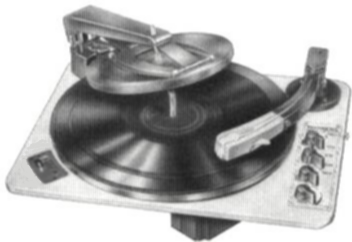
Old Thorens CD-43
This Thorens CD-43 changer cannot take 7-inch records in the same stack with larger records.
These changers have a knob to select between 10-inch and 12-inch intermix operation and 7-inch operation.
The size knob (rearmost of the four) is in the 10-12-inch position.
The records playing on the turntable are 78 rpm. The label size shows this.
To play 7-inch records next, the size control, the speed control, and the stylus must be changed when the record drops.
An advertising "expert" put this photo in magazine ads to show that all three sizes play automatically on it.
They actually made two versions of this photo. One has the slide control (left) the other has the speed knob (right).
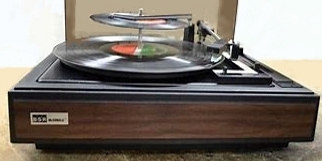
Unknown BSR model
This BSR changer cannot change intermixed record sizes.
This changer has a knob to select operation with 7-inch, 10-inch, or 12-inch records.
The size knob (rearmost) is not visible in this picture.
The record playing on the turntable is a 12-inch 33 rpm. The label size shows this.
To play that 7-inch 45 rpm record next, the size control and the speed control must be changed just before the record drops.
If the controls are not changed after the 12-inch 33 starts, the changer will drop the
7-inch record and restart the 12-inch record.
Then when the arm reaches the 7-inch record, the stylus and the record could
be damaged.
The amateur photographer made this photo to show that these sizes play automatically on it.

Reversed BSR 810
They were so intent on touting the merger of BSR and ADC that they didn't notice a problem in the ad.
They reversed the photo of the record changer.
This was BSR's top of the line - the two-speed 810 with umbrella spindle.
Three start buttons tell the changer the record size - one for each standard size.
It has a repeat control and manual operation.
The page author has repaired a turntable with a backward arm like that. It is in a jukebox.
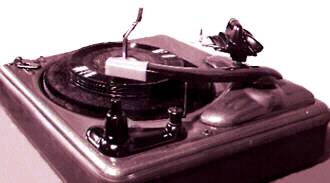
Webster Chicago 356
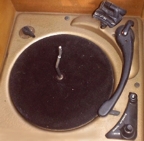
Webster Chicago 256
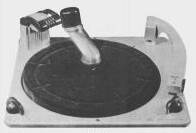
Milwaukee 11600
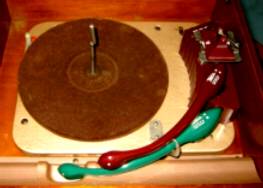
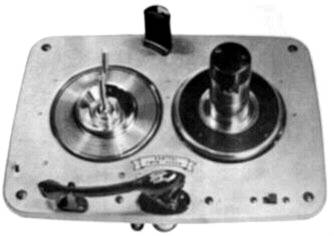

Zenith 33 and 45
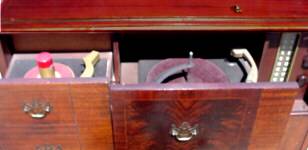
RCA Twin
Record changer companies rushed designs in 1948 - 1951 to get something on the market for all new speeds and sizes.
− This was Webster-Chicago's top of the line 356 (right) - the first 3-speed 3-size changer.
- The changer came with a box of "toys" so it could play different speeds and sizes.
- The arm has two plug-in heads, one for standard groove records and one for microgroove records (shown).
- A special shelf extension is clipped on the pusher shelf in the 10-inch position for dropping 7-inch records (shown).
- The special shelf extension has a selector for 33 or 45 for record rims of different thickness for the two speeds,
- A set of metal spider inserts to change large-hole records to small-hole records was included.
- The restpost is turned a quarter turn to tell the changer it is playing 7-inch records (visible).
- This changer shuts itself off for large records, but repeats the last 7-inch record.
− Webster-Chicago also sold a kit of parts to turn a 256 (right) into what is functionally a 356.
- The kit came with the same box of toys, plus some replacement parts.
- A technician replaced the arm shaft and the rest post as part of the conversion.
- A coil spring was also included. You took off the turntable and put it on the 33 motor step for 45 rpm in the SLOW position.
- You took off the turntable and removed the spring for 33 rpm in the slow position.
- They even provided a stud near the motor shaft to store the spring on.
− Milwaukee-Erwood made model 11600 (right). You select the record size and hole size by changing the spindle.
- It has a spindle for 10-inch and 12-inch, one for small-hole 7-inch, and one for large-hole 7-inch records (shown).
- Plug-in heads change the stylus for microgroove or standard groove records.
- It repeats the last record.
- The change cycle is driven by a spiral on the bottom of the turntable.
− Zenith Two Speed (first photo) has:
- An automatic arm (maroon) for 78
- A manual arm (green) for 33
- Auto shutoff
− Zenith Twin 7 (second photo) has:
- A small-hole 33 rpm turntable
- A large-hole 45 rpm turntable
- A two-position arm to work either turntable
- A pusher post for small hole records
- Repeats the last record
− Zenith 7-inch adaptor (third photo) has:
- A small turntable that clips to the changer spindle of a 78 rpm changer
- A speed selector for 33 and 45
- A tiny manual pickup arm
− RCA (bottom) put two record changers in one console.
- RCA was issuing classical music on "convenient" 45 rpm records.
- The change cycle on the 45 changer is run by a cam on the bottom of the turntable.
- The change cycle takes only one turntable rotation.
- The side breaks are annoying no matter how fast the changer cycles.
- The RCA 45 changer repeats the last record, spoiling the rendition of classical music.
- The 33 - 78 changer shuts off after the last record, but doesn't play 7-inch records automatically.